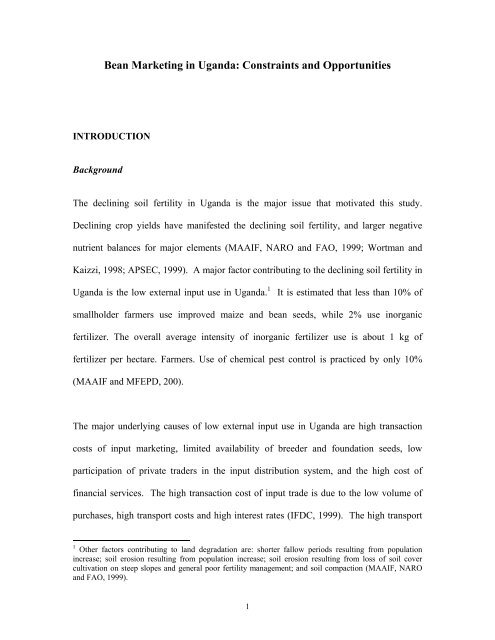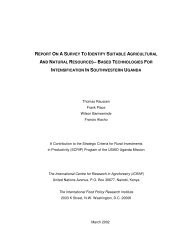Bean Marketing in Uganda - Uganda Strategy Support Program Notes
Bean Marketing in Uganda - Uganda Strategy Support Program Notes
Bean Marketing in Uganda - Uganda Strategy Support Program Notes
You also want an ePaper? Increase the reach of your titles
YUMPU automatically turns print PDFs into web optimized ePapers that Google loves.
<strong>Bean</strong> <strong>Market<strong>in</strong>g</strong> <strong>in</strong> <strong>Uganda</strong>: Constra<strong>in</strong>ts and Opportunities<br />
INTRODUCTION<br />
Background<br />
The decl<strong>in</strong><strong>in</strong>g soil fertility <strong>in</strong> <strong>Uganda</strong> is the major issue that motivated this study.<br />
Decl<strong>in</strong><strong>in</strong>g crop yields have manifested the decl<strong>in</strong><strong>in</strong>g soil fertility, and larger negative<br />
nutrient balances for major elements (MAAIF, NARO and FAO, 1999; Wortman and<br />
Kaizzi, 1998; APSEC, 1999). A major factor contribut<strong>in</strong>g to the decl<strong>in</strong><strong>in</strong>g soil fertility <strong>in</strong><br />
<strong>Uganda</strong> is the low external <strong>in</strong>put use <strong>in</strong> <strong>Uganda</strong>. 1 It is estimated that less than 10% of<br />
smallholder farmers use improved maize and bean seeds, while 2% use <strong>in</strong>organic<br />
fertilizer. The overall average <strong>in</strong>tensity of <strong>in</strong>organic fertilizer use is about 1 kg of<br />
fertilizer per hectare. Farmers. Use of chemical pest control is practiced by only 10%<br />
(MAAIF and MFEPD, 200).<br />
The major underly<strong>in</strong>g causes of low external <strong>in</strong>put use <strong>in</strong> <strong>Uganda</strong> are high transaction<br />
costs of <strong>in</strong>put market<strong>in</strong>g, limited availability of breeder and foundation seeds, low<br />
participation of private traders <strong>in</strong> the <strong>in</strong>put distribution system, and the high cost of<br />
f<strong>in</strong>ancial services. The high transaction cost of <strong>in</strong>put trade is due to the low volume of<br />
purchases, high transport costs and high <strong>in</strong>terest rates (IFDC, 1999). The high transport<br />
1 Other factors contribut<strong>in</strong>g to land degradation are: shorter fallow periods result<strong>in</strong>g from population<br />
<strong>in</strong>crease; soil erosion result<strong>in</strong>g from population <strong>in</strong>crease; soil erosion result<strong>in</strong>g from loss of soil cover<br />
cultivation on steep slopes and general poor fertility management; and soil compaction (MAAIF, NARO<br />
and FAO, 1999).<br />
1
















